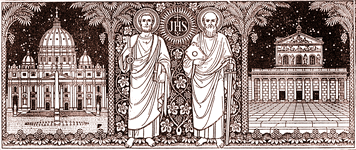Lives of the Saints
Our Models and Protectors
Spiritual Bouquet:
November 18

Dedication of the Basilicas of
Saint Peter and Saint Paul
The ancient basilica of Saint Peter stood, like the present one, on the hill of Rome called in Latin Mons Vaticanus, at the northwestern extremity of the city, on the right bank of the Tiber. What we call the Vatican is a Roman palace, the ordinary dwelling of the Pope. Near the Lateran palace where the early Popes dwelt, which was itself built by Constantine the Great or Saint Liberius, Constantine built on the same hill, over the tomb of Saint Peter called the Confession, the Church of the first Vicar of Christ, where once a Roman circus had stood. This first Christian emperor placed there a plaque to honor Saint Peter, on which he had inscribed:
Because the world under your guidance has risen triumphant to the very heavens, Constantine, victorious, has built this temple to your glory.
The Divine Office for this day narrates its origins as follows:
The Emperor Constantine the Great, on the eighth day after his baptism, after deposing the diadem and prostrating himself, shed a great many tears; then taking up a pick and a shovel, he dug into the soil and drew out twelve loads of earth in honor of the twelve Apostles, thereby designating the site of the basilica he desired to build to honor their Prince. This basilica was dedicated by Pope Saint Sylvester on the fourteenth day of the calendes of December, just as on the fifth of the ides of November he had consecrated the Church of the Lateran, but here he did so by raising a stone altar which he anointed with sacred chrism... When the old Vatican basilica became decrepit, it was rebuilt, through the piety of several Pontiffs, on the same foundations but larger and more magnificent. And in the year 1626, on this same day, Urban VII solemnly consecrated it.
As during the earliest centuries, still today from all corners of the world Christians go to venerate the tomb of the Prince of the Apostles.
The tomb of Saint Paul is on the Ostian Way, at the southern extremity of the city. The characters indicating the Apostle buried there, which clearly date from the epoch of Constantine, are engraved in the marble which closes the sarcophagus: PAULO APOSTOLO ET MARTYRI.
On the same day, Saint Sylvester dedicated the Basilica of Saint Paul the Apostle which the emperor Constantine had also built with magnificence on the Ostian Way, enriching this one, too, with revenues, ornaments and valuable gifts. In the year 1823, a violent fire totally consumed this Basilica, but it was raised again, more beautiful than before, by the persevering zeal of four Pontiffs, who recovered it from its ruins. Pius IX chose for the time of its consecration the blessed occasion of the definition of the Immaculate Conception of the Blessed Virgin Mary, which he had just proclaimed, and which had drawn to Rome from the farthest places of the Catholic world, a number of Bishops and Cardinals. It was on the 10th day of December in 1854, that amid this beautiful crown of prelates and princes of the Church, he carried out the solemn dedication, and fixed its annual commemoration for the present day. (November 18)
Thus the city is laid out between the two pillars of the Church, the two Apostles who from Rome made the Word of God resound throughout the entire world.
L'Année liturgique, by Dom Prosper Guéranger (Mame et Fils: Tours: 1919), The Time after Pentecost, VI, Vol. 15. Translation O.D.M.